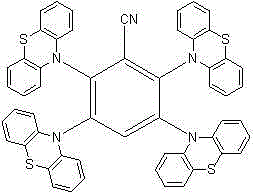Organic electroluminescent device
An electroluminescent device and luminescent technology, applied in the OLED field, can solve the problems of large band gap, high driving voltage, and inability to fully use energy effectively, and achieve good stability, high photoluminescence efficiency, and low price Effect
- Summary
- Abstract
- Description
- Claims
- Application Information
AI Technical Summary
Problems solved by technology
Method used
Image
Examples
Embodiment 1
[0093] Synthesis of C1. Under a nitrogen atmosphere, dissolve 1 mol of potassium tert-butoxide into 20 ml of DML and stir for 1 hour, then add 1 mol of carbazole in the DML solution dropwise, and stir for 1 hour after all the addition is complete. Then, a DMF solution in which 0.2 mol of 2,3,4,5,6-pentafluorobenzonitrile was dissolved was added dropwise and stirred for 5 hours. Then the reaction solution was poured into water and filtered to obtain a solid. Separation with a chromatographic column. C1 was obtained with a yield of 90%.
[0094] Mass spectrum: 929.
[0095] Elemental analysis: C: 86.60, H: 4.35, N: 9.05.
Embodiment 2
[0097] Synthesis of C2. The reactant carbazole was replaced by tert-butyl carbazole, and C2 was obtained through the same synthesis method as in Example 1, with a yield of 91%.
[0098] Mass spectrum: 1490.
[0099] Elemental analysis: C: 86.20, H: 8.16, N: 5.64.
Embodiment 3
[0101] Synthesis of C3. The reactant carbazole was replaced by phenylcarbazole, and C3 was obtained through the same synthesis method as in Example 1, with a yield of 91%.
[0102] Mass spectrum: 1689.
[0103] Elemental analysis: C: 90.20 H: 4.83 N: 4.97.
PUM
 Login to View More
Login to View More Abstract
Description
Claims
Application Information
 Login to View More
Login to View More - R&D
- Intellectual Property
- Life Sciences
- Materials
- Tech Scout
- Unparalleled Data Quality
- Higher Quality Content
- 60% Fewer Hallucinations
Browse by: Latest US Patents, China's latest patents, Technical Efficacy Thesaurus, Application Domain, Technology Topic, Popular Technical Reports.
© 2025 PatSnap. All rights reserved.Legal|Privacy policy|Modern Slavery Act Transparency Statement|Sitemap|About US| Contact US: help@patsnap.com



